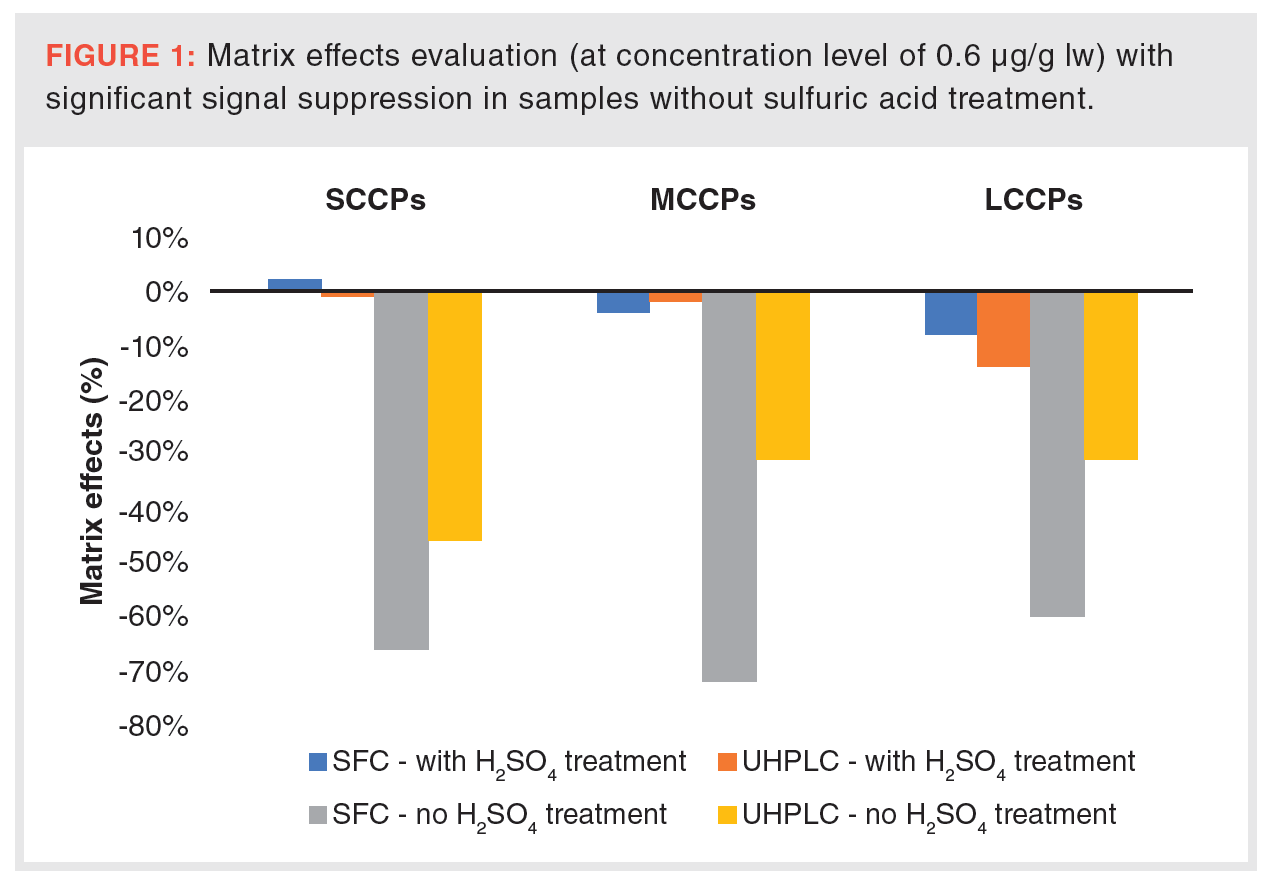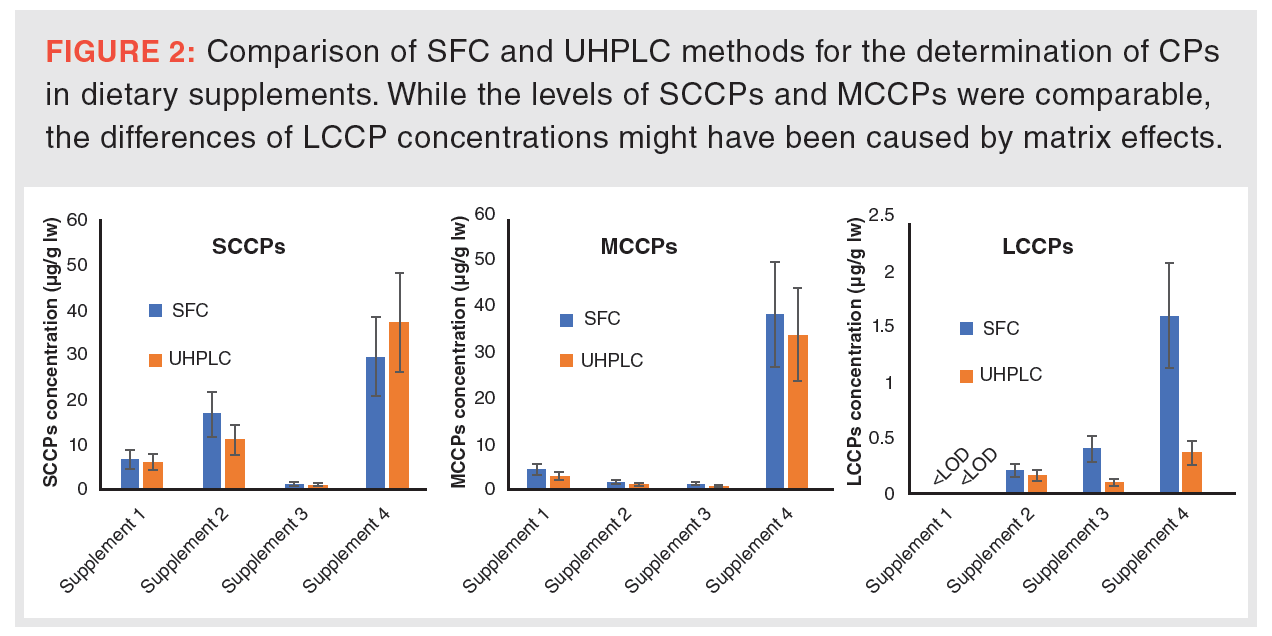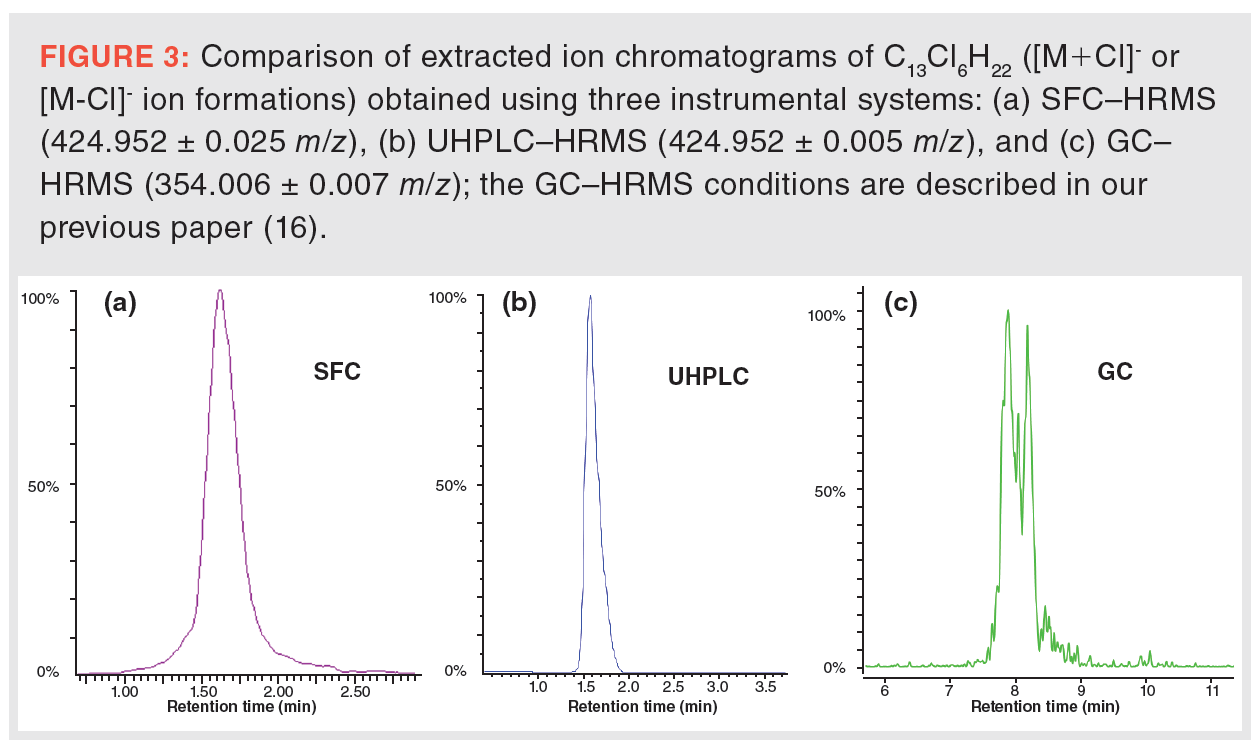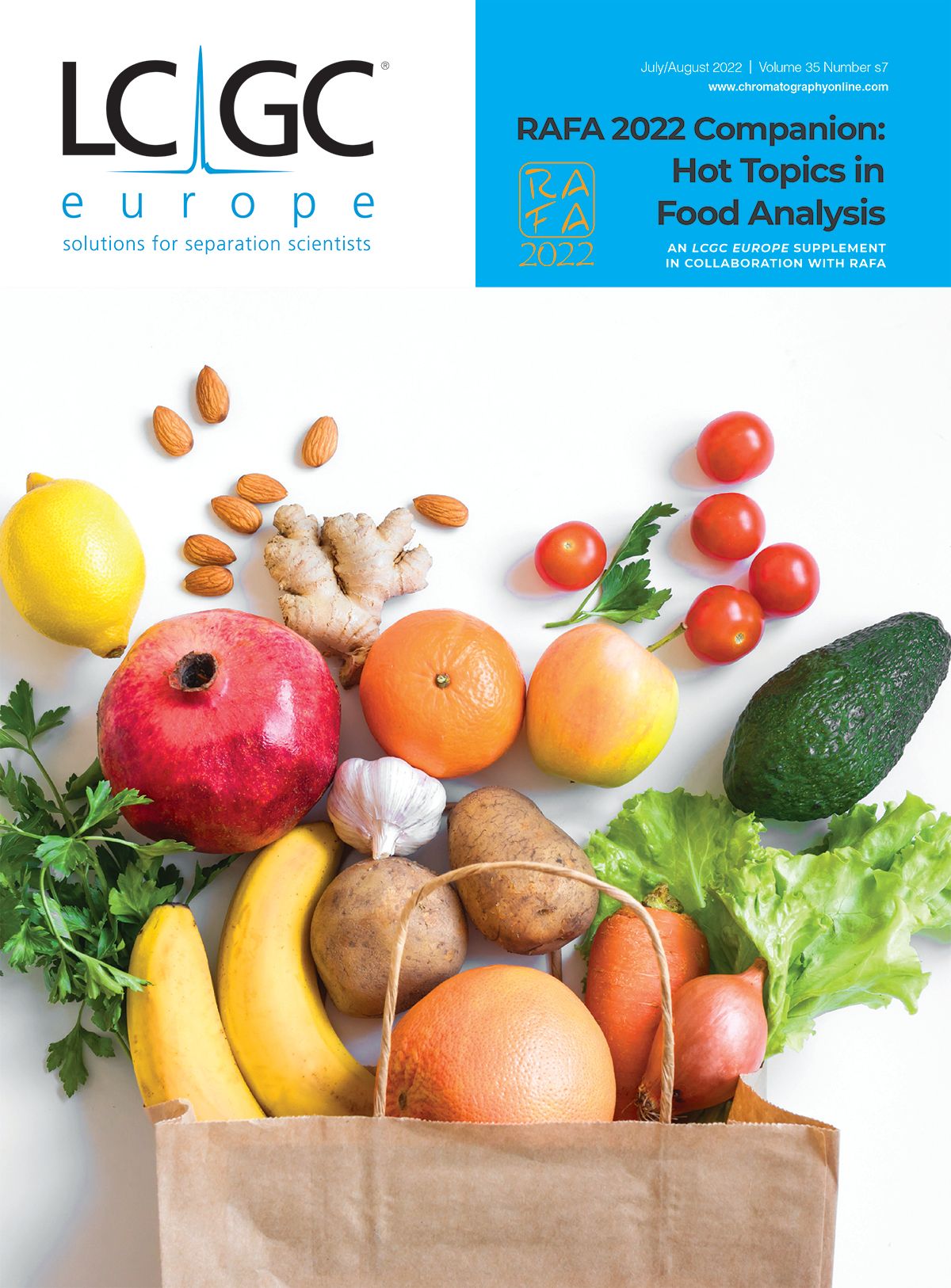Application of Liquid- and Supercritical Fluid Chromatography Coupled with High-Resolution Mass Spectrometry for the Analysis of Short-, Medium-, and Long-Chain Chlorinated Paraffins in Dietary Supplements
Chlorinated paraffins (CPs) are an emerging and ubiquitous group of environmental pollutants associated with adverse effects on human health, including endocrine disruption and possible carcinogenicity. In this study, supercritical fluid chromatography (SFC) and ultrahigh-performance liquid chromatography (UHPLC) — both coupled with high-resolution mass spectrometry (HRMS) — methods for the analysis of short-, medium-, and long-chain CPs in fish oil-based dietary supplements were developed and validated at concentration levels of 0.6 and 3.0 µg/g lipid weight (lw). The recoveries were in the range of 80–96% and repeatabilities, expressed as relative standard deviations, were <19%. The limits of detection for the UHPLC–HRMS method (from 0.03 to 0.05 µg/g lw) were 5 to 10 times lower than those obtained by SFC–HRMS (from 0.13 to 0.50 µg/lw).
Chlorinated paraffins (CPs) are widespread environmental pollutants, and are used predominantly as additives (such as plasticizers and flame retardants) in plastic materials (1,2), high temperature and pressureresistant lubricants, metal‑working fluids, and flame retardants in adhesives and textiles (3).
CPs are divided into three main groups by their carbon chain lengths: (i) short-: (SCCPs; C10–C13), (ii) medium-: (MCCPs; C14–C17), and (iii) long-chain chlorinated paraffins (LCCPs: C18–C30) (4).
SCCPs are endocrine disruptors (5) and possible carcinogens to humans (6), therefore, they were added to the Stockholm Convention (Annex A) in 2017 as persistent organic pollutants (POPs) (7). The data on both MCCPs and LCCPs adverse effects on human health are very limited, and so they are not currently regulated (8). On the other hand, MCCPs are under evaluation for listing in the Stockholm Convention, and the risk assessment and risk profile are being performed (7).
The instrumental analysis of CPs in food and biological samples (usually at trace levels) (9,10) is a demanding task. In recent years, several gas chromatography (GC) or liquid chromatography (LC) -based methods have been published (9–12). Nevertheless, CPs cannot be completely separated to individual compounds, which has led (together with the lack of well‑characterized standard mixtures) to the need for unconventional quantification approaches (13–15). The LCCP standards have the least available options on the market.
The main goal of this study was to develop and validate supercritical fluid chromatography (SFC) and ultrahigh-performance liquid chromatography (UHPLC)—both coupled with high-resolution mass spectrometry (HRMS) with electrospray ionization operated in negative mode (ESI-)—methods for the determination of CPs (particularly LCCPs as those cannot be analyzed by GC–HRMS due to low vapour pressure). Fish oil dietary supplements were selected as the sample matrix, as an example of an adequately complex type of sample. The validated methods are necessary for future studies to assess the CPs levels in food and the environment, particularly for LCCPs, which are the least studied among the major CP groups.
Materials and Methods
Standard Solutions and Chemicals: Thirty-one standard mixtures of SCCPs, MCCPs, and LCCPs of 10 µg/mL or 100 µg/mL cyclohexane with various chlorine contents (from 36.0% to 65.3%) were obtained from LGC Standards. The detailed list is documented in our previous paper (16). Isotopically labelled internal standard of β-hexabromocyclododecane (13C12-β-HBCD; 50 µg/mL toluene) was purchased from Wellington Laboratories.
Acetonitrile, methanol, n-hexane, ethyl acetate, and isopropanol were obtained from Honeywell. Dichloromethane, isooctane, sulfuric acid, ammonium formate, and silica gel 60 (particle size 0.063–0.200 mm) were purchased from Merck, while sodium sulfate (anhydrous) was bought from Lach-Ner. Deionized water was made by a water purification system Milli–Q by Merck. Technical gases (carbon dioxide 4.8 and nitrogen 4.0) were supplied by SIAD.
Sample Preparation Procedure: In this study, a sample of fish oil‑based dietary supplement with no measurable CPs contamination found in a previous study (16) was chosen for method development and validation. Four other samples (with higher levels of CPs contamination previously determined by GC–HRMS) were analyzed to compare the new methods. A multilayer solid-phase extraction (SPE) was used in this study for the sample preparation. Briefly, the CPs were isolated from fish oil on an SPE column (78 × 12 mm with Luer tip) (LCTech GmbH) filled with (from bottom to top) silica gel (0.5 g; deactivated by 2% deionized water, w/w), sodium sulfate (1 g; anhydrous baked for 4 h at 600 °C), and sulphuric acid-modified silica gel (1 g; 40% of H2SO4, w/w). Each column was washed with 3:1 (v/v) n-hexane–dichloromethane and then conditioned with n-hexane. A 100-mg measure of the sample diluted in n-hexane was loaded onto the SPE column and the analytes were eluted with 3:1 v/v n-hexane–dichloromethane. The sample was subsequently concentrated by a rotary vacuum evaporator followed by drying in a gentle stream of nitrogen. It was then dissolved in 500 µL of n-hexane, and the residual lipids were subsequently mineralized by a few drops of concentrated sulfuric acid. After one hour, an aliquot of 250 µL was evaporated and redissolved in 250 µL of the syringe standard (50 ng/mL 13C12-β-HBCD) in acetonitrile.
Instrumental Analysis:
UHPLC–ESI(-)–HRMS Analysis:
The LC–ESI(-)–HRMS analysis of CPs was performed by Dionex UltiMate 3000 UHPLC system (Thermo Fisher Scientific) coupled with a TripleTOF 6600 HRMS system (Sciex) with electrospray ionization operated in a negative mode. The method was developed from initial conditions published elsewhere (17). In this study, the target analytes (injection volume 5 µL acetonitrile) were separated on a 100 × 2.1 mm, 1.7-µm Acquity UPLC BEH C18 (Waters) column maintained at 40 °C. Methanol (A) and a mixture of 65:30:5 (v/v/v) isopropanol–methanol–water (B) were used as mobile phases. The initial conditions were 10% B for 1 min followed by a gradient with the following steps: to 30% B at 1.5 min, to 60% B at 2 min, to 80% at 3 min, to 90% B at 3.5 min, to 100% B at 4 min (3.5 min isocratic hold; the total run time was 11 min including the return to the initial state and equilibration). The mobile phase flow rate was 0.2 mL/min.
Regarding MS source conditions, desolvation temperature was set to 450 °C and the capillary voltage was -4.5 kV. The acquisition speed was 2 spectra/s and the mass range 100 to 1500 m/z. The [M+Cl]- ions were monitored.
SFC–ESI(-)–HRMS Analysis:
A previously published SFC-based method (16) was used in this study with several modifications (gradient of mobile phases, composition of mobile phase B, and make‑up solvent were changed). The supercritical fluid chromatograph Acquity UPC2 coupled with a Synapt G2 Si high-resolution mass spectrometer (both Waters) with electrospray ionization operated in a negative mode was employed. The target analytes (injection volume 3 µL acetonitrile) were separated on a 100 × 3.0 mm, 1.8-µm Viridis HSS C18 SB (Waters) column maintained at 70 °C. Supercritical CO2 was used as mobile phase A and 5 mM ammonium formate in 99:1 (v/v) methanol–water was employed as mobile phase B. The initial conditions were 100% A for 0.5 min followed by a gradient to 35% B at 5 min (1 min isocratic hold; the total run time was 8 min including the return to the initial state and equilibration). The mobile phase flow rate was 1.8 mL/min. After the separation under supercritical conditions, the CO2 evaporated and had to be substituted by another mobile phase—a make-up solvent—which leads the analytes into the ion source. In this study, the make-up solvent was a mixture of 45:45:10 (v/v/v) methanol–ethyl acetate–dichloromethane (flow rate 0.5 mL/min).
In the MS system, the desolvation gas temperature was 250 °C and the capillary voltage was set to -3 kV. The acquisition speed was 2 spectra/s and the mass range 250 to 1500 m/z. The [M+Cl]- ions were monitored.
Method Validation: The analytical method for the determination of SCCPs, MCCPs, and LCCPs was validated by the analysis of artificially contaminated samples (at two different concentration levels, each level prepared in six parallels). The selected spike levels were 0.6 and 3 µg/g lw for each of the CP groups. The standard mixtures used were C10–C13 63.0% Cl; C14–C17 57.0% Cl, and C18–C20 49.0% Cl. The limits of detection (LODs) were determined as the lowest standard level at which any CP congener group was integrable (with S/N ≥ 10).
Evaluation of Matrix Effects:The matrix effects were evaluated by comparing matrix standards (prepared in duplicate) with solvent standards at a level of 0.6 µg/g lw. The equation used for the evaluation was described elsewhere (12). The sample preparation was performed as described in the “Methods and Materials” section. For a comparison, matrix effects of the extract with residual lipids (without sulfuric acid treatment) were evaluated as well.
Results and Discussion
Comparison of Method Performance Characteristics of SFC and UHPLC-Based Methods for the Analysis of CPs in Fish Oil-Based Dietary Supplements: The method performance characteristics of SFC–HRMS and UHPLC–HRMS methods for analysis of SCCPs, MCCPs, and LCCPs are shown in Table 1. There are no officially recommended reference values for recovery and repeatability in the analysis of CPs, therefore the acceptable values (recovery from 60 to 120% and repeatability <20%) were adopted from Commission Regulation (EU) 2017/644 (18) concerning sampling and analysis of polychlorinated dibenzodioxins/furans and polychlorinated biphenyls (other chlorinated POPs) in foodstuffs. The recoveries varied from 84 to 95% (SFC‑based instrumental method) and from 80 to 96% (UHPLC-based instrumental method), respectively. The repeatabilities (expressed as relative standard deviations, RSDs) were <19%. Both methods were therefore successfully validated on levels of 0.6 and 3 µg/g lw, with no significant differences regarding recovery and repeatability. The UHPLC instrumentation proved to yield lower LODs (5 to 10 times lower, see Table 1) than the SFC method (probably due to the presence of splitter on the interface of SFC and MS). On the other hand, the SFC proved to be a robust method regarding injection solvent, that is, the use of acetonitrile in this study and isooctane used elsewhere (16), where the samples prepared for GC–HRMS analysis (in isooctane) were also measured by SFC–HRMS (as a complementary method for screening of LCCPs).

Matrix Effects Evaluation: The matrix effects are illustrated in Figure 1. The positive effect of a sulfuric acid treatment is documented there. In samples without the sulfuric acid treatment, there can be seen a strong signal suppression, which was more significant in SFC (with a response decrease of up to 69% for the MCCPs). The signal suppression was presumably caused by methyl or ethyl esters of fatty acids, as these esters are sometimes a dominant form of fatty acids in concentrated fish oil-based dietary supplements (19). The free fatty acids released from ester bonds by sulfuric acid were then separated from CPs on the chromatographic column, decreasing effectively the matrix effects, which was verified by successful validation.

SFC and UHPLC Method Comparison: The Determination of CPs in Fish Oil-Based Dietary Supplements: For the developed and validated methods final comparison, the methods were used for determination of CPs in four fish oil-based dietary supplements (Figure 2). Chromatograms illustrating the separation differences of several chromatographic systems are shown in Figure 3. The concentrations of SCCPs and MCCPs obtained employing SFC and UHPLC systems were comparable (considering 30% uncertainty). The concentrations were in the range of 1.01–37.22 µg/g lw (SCCPs) and 0.83–37.76 µg/g lw (MCCPs), respectively. These results were lower than concentrations obtained by GC–HRMS in our previously published study (16). The differences may have been caused by still remaining matrix effects, even after sulfuric acid treatment of the samples. Similarly, concentrations of LCCPs obtained by UHPLC–HRMS (0.10–0.36 µg/g lw) were in the samples 3 and 4 lower than those obtained by SFC–HRMS (0.20–1.59 µg/g lw). The differences might have been caused by slightly higher matrix effects (Figure 1).


Conclusions
This article describes a validation of two analytical approaches (employing SFC- and UHPLC‑based methods) with a single sample preparation procedure for the analysis of SCCPs, MCCPs, and LCCPs in fish oil-based dietary supplements. The recoveries ranged from 80 to 96% (with RSDs <19%). The UHPLC instrumentation showed lower LODs than SFC, but SFC demonstrated a good robustness because acetonitrile or isooctane extracts could be analyzed under the same conditions.
The methods were then used to determine CPs contamination in four samples of dietary supplements. The SCCP and MCCP concentrations obtained by both systems were comparable, while the LCCP concentrations differed (with UHPLC yielding lower results). The SCCP and MCCP levels were also compared with results obtained employing GC–HRMS (which were previously published). The results obtained by SFC and UHPLC were slightly lower than those obtained by the GC-based method. This might have been caused by matrix effects in some samples, and in the following studies further research is needed (that is, selection of a 13C-labelled CP internal standard and/or use of a more complex clean-up procedure). Finally, the methods are planned to be verified in interlaboratory studies.
Acknowledgements
This work was financially supported by the Czech Science Foundation (21-19437S). The support from the grants of specific university research – grants No. A1_FPBT_2022_005 and A2_FPBT_2021_018 are also gratefully acknowledged.
References
- T.J. McGrath, G. Poma, H. Matsukami, et al., Int. J. Environ. Res. Public Health 18(3), 1069 (2021).
- C. Wang, W. Gao, Y. Liang, et al., Chemosphere 225, 557–564 (2019).
- UNEP, Risk management evaluation: short-chain chlorinated paraffins (2016).
- L.M. van Mourik, C. Gaus, P.E. Leonards, et al., Chemosphere 155, 415–428 (2016).
- H. Li, S. Gao, M. Yang, et al., Chemosphere 244, 125393 (2020).
- IARC: http://monographs.iarc.fr/ENG/Classification/index.php (accessed 2.11.).
- Stockholm Convention: http://chm.pops.int/Convention/POPsReviewCommittee/Chemicals/tabid/243/Default.aspx (accessed 30.9.2021).
- J. Gluge. L. Schinkel, K. Hungerbuhler, et al., Environ. Sci. Technol. 52(12), 6743–6760 (2018).
- I. Perkons, E. Abdulajeva, E. Bartkiene, et al., Sci. Total Environ. 814, 152733 (2022).
- T.J. McGrath, F. Limonier, G. Poma, et al., Environ. Pollut. 291, 118236 (2021).
- K. Kratschmer, A. Schachtele, W. Vetter, et al., Environ. Pollut. 272, 116019 (2021).
- J. Tomasko, M. Stupak, and J. Hajslova, Food Chem. 355, 129640 (2021).
- M. Meziere, K. Kratschmer, I. Perkons, et al., J. Am. Soc. Mass Spectrom. 31(9), 1885–1895 (2020).
- C. Bogdal, T. Alsberg, P.S. Diefenbacher, et al., Anal. Chem. 87(5), 2852–60 (2015).
- M. Reth, Z. Zencak, and M.J. Oehme, J. Chromatogr. A 1081(2), 225–31 (2005).
- J. Tomasko, V. Hrbek, T. Kourimsky, et al., Sci Total Environ. 155137 (2022).
- T. Li, Y. Wan, S. Gao, et al., Environ. Sci. Technol. 51(6), 3346–3354 (2017).
- Commision Regulation, COMMISSION REGULATION (EU) 2017/644 (2017).
- C.A. Pieck, C. Crampon, and F. Charton, The Journal of Supercritical Fluids 120, 258–265 (2017).
Jakub Tomasko is a Ph.D. student in the Department of Food Analysis and Nutrition, University of Chemistry and Technology, Prague (Czech Republic). His main research interests are analysis of chlorinated paraffins and mineral oil hydrocarbons.
David Maxa is a master’s student in the Department of Food Analysis and Nutrition, UCT Prague. His research topic is on the analysis of chlorinated paraffins employing liquid chromatography‑based techniques.
Klara Navratilova is a Ph.D. student at the Department of Food Analysis and Nutrition, UCT Prague. Her research is focused on the application of LCÐHRMS in metabolomic and lipidomic studies.
Tomas Kourimsky is a Ph.D. student in the Department of Food Analysis and Nutrition, UCT Prague. His research is focused on the analysis of MCPD and its esters employing GCÐMS/MS and SFCÐHRMS.
Vojtech Hrbek is a research assistant in the Department of Food Analysis and Nutrition, UCT Prague. His main research interests (but not limited to) are the application of (high resolution) mass spectrometry in the analysis of bioactive compounds and contaminants in food.
Jana Hajšlova is a professor at UCT Prague. She is the head of ISO 17025/2018 accredited laboratory and also heads a research group concerned with separation science in the field of food analysis.
Jana Pulkrabova is a professor of food chemistry and analysis and Head of the Department of Food Analysis and Nutrition at UCT Prague. Her research group studies groups of organic pollutants in food, internal and external environment, and human biological monitoring.

New Study Reviews Chromatography Methods for Flavonoid Analysis
April 21st 2025Flavonoids are widely used metabolites that carry out various functions in different industries, such as food and cosmetics. Detecting, separating, and quantifying them in fruit species can be a complicated process.
Analytical Challenges in Measuring Migration from Food Contact Materials
November 2nd 2015Food contact materials contain low molecular weight additives and processing aids which can migrate into foods leading to trace levels of contamination. Food safety is ensured through regulations, comprising compositional controls and migration limits, which present a significant analytical challenge to the food industry to ensure compliance and demonstrate due diligence. Of the various analytical approaches, LC-MS/MS has proved to be an essential tool in monitoring migration of target compounds into foods, and more sophisticated approaches such as LC-high resolution MS (Orbitrap) are being increasingly used for untargeted analysis to monitor non-intentionally added substances. This podcast will provide an overview to this area, illustrated with various applications showing current approaches being employed.








